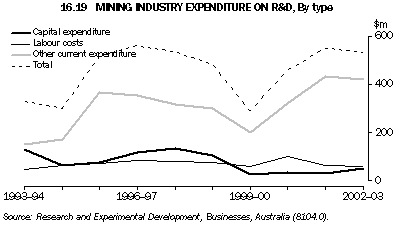Research and experimental development (R&D) activity, in the business context, is defined as systematic investigation or experimentation involving innovation or technical risk, the outcome of which is new knowledge, with or without a specific practical application or new or improved products, processes, materials, devices or services. R&D activity also extends to modifications to existing products and processes.
Over the period 1993-94 to 2002-03, R&D expenditure by the mining industry increased by 62% from $331m in 1993-94 to $536m in 2002-03. R&D expenditure by other industries also increased but more significantly (95%). As a result, the mining industry's contribution to all industries R&D expenditure fell from 10.6% in 1993-94 to 9.0% in 2002-03. The manufacturing industry's share of total R&D expenditure continued to be the highest, accounting for 47% in 2002-03.
Graph 16.19 shows the type of R&D expenditure by the mining industry. For the period 1993-94 to 2002-03 current expenditure other than labour costs is the major component of R&D expenditure for the mining industry, accounting for 79% of mining R&D expenditure in 2002-03. This category includes expenses on materials, fuels, rent and hiring, repairs and maintenance and data processing etc. and the proportion of expenses on general services and overheads attributable to R&D activity. In the mining industry, these expenses increased by $272m (179%) from $152m in 1993-94 to $425m in 2002-03. The amount spent on labour increased by $11m (23%) while capital expenditure fell by $79m (61%). As a result, labour cost and capital expenditure as a proportion of total R&D expenditure fell to 11% and 9.5% respectively in 2002-03. The proportion for capital expenditure was significantly lower than the proportion of 39% recorded in 1993-94.
